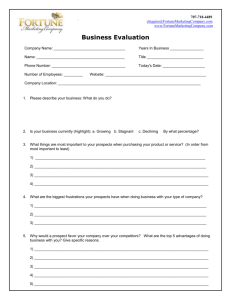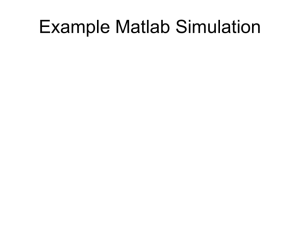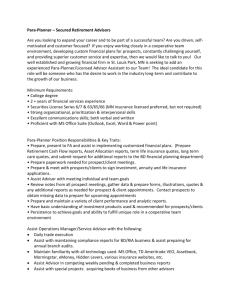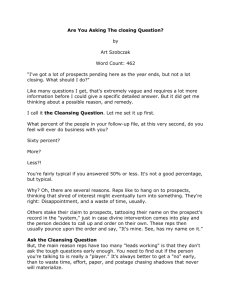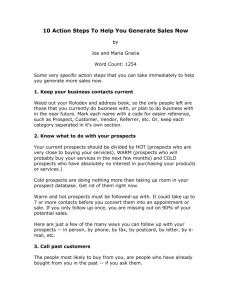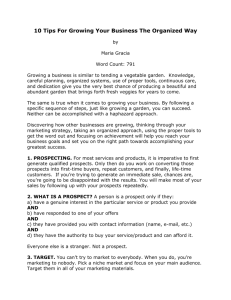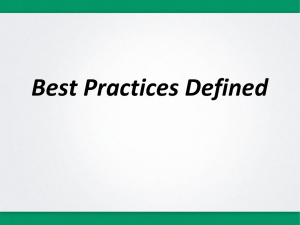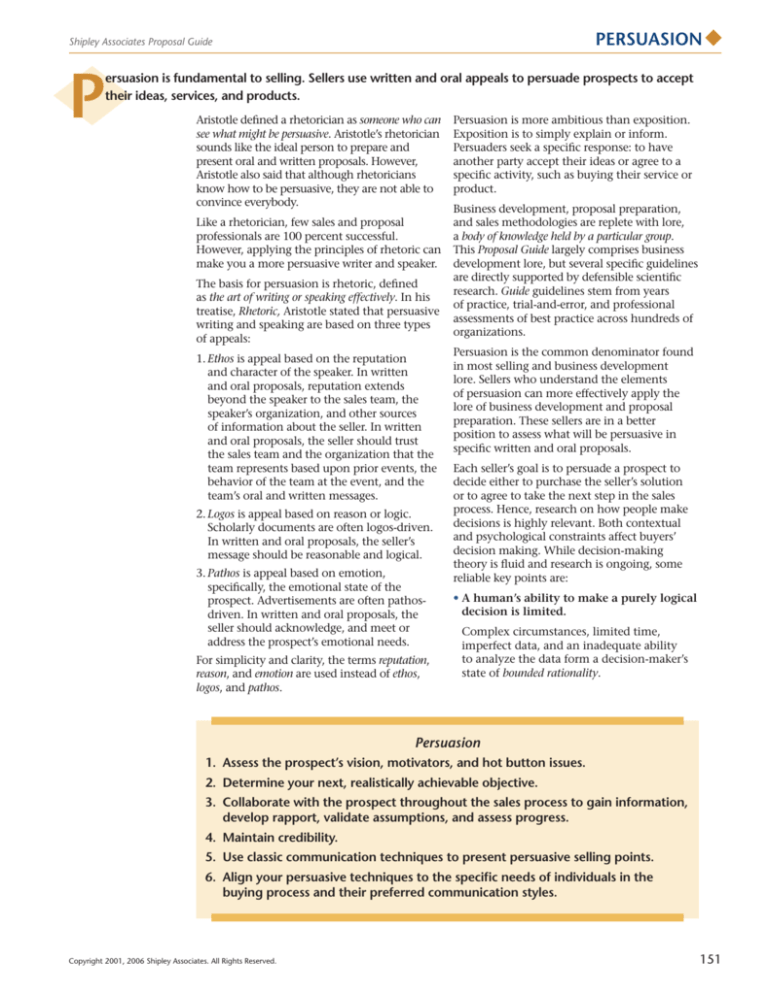
Persuasion
Shipley Associates Proposal Guide
P
ersuasion is fundamental to selling. Sellers use written and oral appeals to persuade prospects to accept
their ideas, services, and products.
Aristotle defined a rhetorician as someone who can
see what might be persuasive. Aristotle’s rhetorician
sounds like the ideal person to prepare and
present oral and written proposals. However,
Aristotle also said that although rhetoricians
know how to be persuasive, they are not able to
convince everybody.
Like a rhetorician, few sales and proposal
professionals are 100 percent successful.
However, applying the principles of rhetoric can
make you a more persuasive writer and speaker.
The basis for persuasion is rhetoric, defined
as the art of writing or speaking effectively. In his
treatise, Rhetoric, Aristotle stated that persuasive
writing and speaking are based on three types
of appeals:
1.Ethos is appeal based on the reputation
and character of the speaker. In written
and oral proposals, reputation extends
beyond the speaker to the sales team, the
speaker’s organization, and other sources
of information about the seller. In written
and oral proposals, the seller should trust
the sales team and the organization that the
team represents based upon prior events, the
behavior of the team at the event, and the
team’s oral and written messages.
2.Logos is appeal based on reason or logic.
Scholarly documents are often logos-driven.
In written and oral proposals, the seller’s
message should be reasonable and logical.
3.Pathos is appeal based on emotion,
specifically, the emotional state of the
prospect. Advertisements are often pathosdriven. In written and oral proposals, the
seller should acknowledge, and meet or
address the prospect’s emotional needs.
For simplicity and clarity, the terms reputation,
reason, and emotion are used instead of ethos,
logos, and pathos.
Persuasion is more ambitious than exposition.
Exposition is to simply explain or inform.
Persuaders seek a specific response: to have
another party accept their ideas or agree to a
specific activity, such as buying their service or
product.
Business development, proposal preparation,
and sales methodologies are replete with lore,
a body of knowledge held by a particular group.
This Proposal Guide largely comprises business
development lore, but several specific guidelines
are directly supported by defensible scientific
research. Guide guidelines stem from years
of practice, trial-and-error, and professional
assessments of best practice across hundreds of
organizations.
Persuasion is the common denominator found
in most selling and business development
lore. Sellers who understand the elements
of persuasion can more effectively apply the
lore of business development and proposal
preparation. These sellers are in a better
position to assess what will be persuasive in
specific written and oral proposals.
Each seller’s goal is to persuade a prospect to
decide either to purchase the seller’s solution
or to agree to take the next step in the sales
process. Hence, research on how people make
decisions is highly relevant. Both contextual
and psychological constraints affect buyers’
decision making. While decision-making
theory is fluid and research is ongoing, some
reliable key points are:
•A human’s ability to make a purely logical
decision is limited.
Complex circumstances, limited time,
imperfect data, and an inadequate ability
to analyze the data form a decision-maker’s
state of bounded rationality.
Persuasion
1.Assess the prospect’s vision, motivators, and hot button issues.
2. Determine your next, realistically achievable objective.
3. Collaborate with the prospect throughout the sales process to gain information,
develop rapport, validate assumptions, and assess progress.
4. Maintain credibility.
5.Use classic communication techniques to present persuasive selling points.
6.Align your persuasive techniques to the specific needs of individuals in the
buying process and their preferred communication styles.
Copyright 2001, 2006 Shipley Associates. All Rights Reserved.
151
Persuasion Shipley Associates Proposal Guide
•Humans knowingly make unreasonable
decisions.
•Every decision involves reason and
emotion.
Research with brain-damaged patients shows
that when logic is cut off from emotion,
patients could not make decisions. PET
(positron emission tomography) and fMRI
(functional magnetic resonance imaging)
scans show that all decisions involve a
complex interplay between the emotional
and logical centers of the human brain.
Individuals in controlled experiments and
real life situations will ignore their economic
best interest (reason) and make decisions
for emotional reasons (anger, revenge,
immediate gratification, irrational fear, risk
avoiding, or risk seeking). Essentially, the
emotional sector of the brain overrides the
reasoning sector.
Which type of appeal is most effective? Aristotle
said reputation was the most effective appeal,
based upon trust in the credibility of the
1
speaker. Advertisers rely heavily on appeals to
the emotions of the prospect, but use credible
speakers to deliver the message. Most sellers
make “reasonable” arguments, even though
their arguments might not withstand the
scrutiny of the prospect or a logician.
Reputation, reason, and emotion are all
essential persuasive elements in crafting
complex sales arguments. Like a three-legged
stool that is unstable with a single leg removed,
you are far less likely to make the sale if you
omit any element.
All techniques recommended in this Proposal
Guide are rhetorical devices originating in
Aristotle’s three types of appeals. The guidelines
in this section integrate the research on what is
persuasive with the lore of selling and proposals.
Fortunately, if you are an experienced proposal
writer you have probably been using many
of these techniques. Ideally, you will become
a rhetorician skilled at blending reputation,
reason, and emotion in an integrated appeal
that might be more persuasive.
Assess the prospect’s vision, motivators, and hot button issues.
Most motivators are
directly linked to reason.
However, the individuals’
identifying motivators
are often influenced by
their personal emotional
needs.
Similarly, organizational
motivators drive
organizations; personal
motivators drive
individuals who make
or influence purchasing
decisions.
See Features,
Advantages, and
Benefits and Strategy.
152
Start with the premise that people seek benefits
based on two factors:
•Perception: whether it is good or bad
•Possession: whether we have it or not
Buyers seek one of four types of benefits derived
from perception or possession as illustrated
in figure 1, and sellers promise benefits in
exchange for money or power. Sellers must link
their solution to the prospect’s needs.
Effective sellers begin by analyzing prospect
needs, and by determining their organizational
vision, motivators, and hot button issues.
source. Is this an issue because the prospect does
not trust you or your organization, because the
prospect cannot see a logical reason to purchase
or cannot see how to justify the purchase, or
because the prospect has an emotional need?
The prospect’s issues typically become
motivators:
•Improve profits
•Increase sales
•Reduce costs
•Improve safety
•Reduce risk
Vision refers to the prospect’s organizational
•Improve quality
image of what the future will or could be like.
•Increase productivity
Sellers that clearly demonstrate how their
solutions will help prospects achieve their
All motivators are issues, but not all issues are
vision usually win the sale. Note how this vision motivators. In complex sales, most motivators
statement powerfully appeals to reason and
usually stem from reason and are logical.
emotion:
Hot button issues are a consolidated subset
Imagine: doctors operating on a patient can point a
of issues and motivators. Typical hot button
RxT laser at live tissue, analyze the reflected light with
a spectroscope and PC, and immediately determine
issues are owned and repeatedly cited by
if the tissue is malignant or benign. Further imagine
several people in the prospect organization.
that this scenario can be made real within 16 months
Since hot button issues often relate to
if you fund our program.
reputation, reason, and emotion, address them
Issues are the prospect’s concerns—the worry
by incorporating all three types of appeals.
items that keep the prospect’s managers awake at
night. To address issues effectively, determine the
Copyright 2001, 2006 Shipley Associates. All Rights Reserved.
Persuasion
Shipley Associates Proposal Guide
Figure 1. Buyers Seek Four-Types of Benefits. Buyers’ motivations rely on their perceptions of good, bad, and
possession. The four possible combinations are: 1) Maintain: Keep the good; 2) Acquire: Get the good; 3) Relieve: Get rid
of the bad; 4) Protect: Avoid the bad.
2
See Sales Letters.
Define your next, realistically achievable objective.
Prospects become customers via a consistent,
cyclical process:
•Operating in their normal environment. In
normal environments, things age, wear, and
decay; prospects needs evolve.
•Assessing need. Prospects perceive a need or
opportunity to improve and then determine
if they really have a problem/opportunity.
•Valuing solutions. Determining which, if any,
solution offers the best value.
•Resolving remaining issues with the solution
that offers the best value.
•Purchasing.
•Implementing the solution.
•Operating in their normal environment.
Persuasion can be applied at every phase.
To advance the sale, determine where prospects
are in the process. Find answers to their
questions, and then state your next, realistically
achievable objective. Exactly what would you like
this prospect to agree to do next?
Before attempting to persuade prospects to
take action, test your readiness by asking three
things:
1.Where are they going? (Vision, objective, or
goal)
2.What is their next realistically achievable
step towards that goal? (Advance complex
sales in a series of steps.)
3.Why is it in their best interest to agree to
take the next step? (Motivators, hot button
issues)
Copyright 2001, 2006 Shipley Associates. All Rights Reserved.
Advance at the prospect’s pace; pushing the
pace in a complex sale alienates the prospect.
Perhaps the only tactic sellers can effectively use
to increase the pace is to note the opportunity
cost as the prospect delays implementing
improvements.
Determine what credible combination of reason
and emotion will address prospects’ underlying
issues. If you misjudge prospects’ issues at this
point in their purchase-decision process or
cannot adequately answer their questions, you
risk not advancing, delaying the purchase, or
losing the sale.
Examples of not seeking to advance the sale and
advancing too fast:
Not seeking to advance the sale
Thank you for agreeing to meet with me today. Should
you have any questions in the future, please do not
hesitate to call.
Advancing too fast
Thank you for agreeing to meet with me today. We offer
the best environmental remediation services available in
North America. Can I have your purchase order today so
that we can reserve a place in our June work schedule?
State sales objectives clearly so they will be easy
to assess. If sales objectives are vague, no one
can tell when or if they are met.
Examples of next, realistically achievable
objectives:
• Agree to tour a site where your system is operating,
preferably Wednesday, December 4, at 10 AM.
• Agree to collect and share their engine design
specifications and productions costs, sending them
to U.S. via courier by 4 PM, September 30.
153
Persuasion Shipley Associates Proposal Guide
• Agree to meet Thursday, 8 AM, to review and
approve final drawings and specifications.
• Agree to consider a change order, adding
construction management services to our ongoing
design contract.
Vague sales objective
I plan to meet with the prospect to better understand
their future needs.
This objective leaves many details unattended.
When is the meeting? How many meetings will it
take and who will attend? What understanding is
sufficient? Where is this going?
The generic sales cycle illustrated in figure 2
illustrates sales phases (linked arrows) and
tactical steps (boxes) a seller might take to
advance a sale. Whether a meeting, phone call,
or document, the objective for each tactical step
is to incrementally advance the sale.
This visual representation
of the sales cycle follows
the same business
development process
defined in Process, rules
2 and 3.
Figure 2. Sales Cycle, Tactical Steps, and Sales Objectives. Each tactical step has a specific,
measurable, realistically achievable, sales objective.
3
See Strategy.
Collaborate with the prospect throughout the sales process to gain information,
develop rapport, validate assumptions, and assess progress.
Collaboration is persuasive because it integrates
appeals based on reason, emotion, and reputation. While most collaborative discussions are
based on reason, both parties disclose emotional
needs. Prospects willingly share information in a
collaborative situation. Collaboration builds trust
and credibility; ongoing collaboration nurtures
this emotional bond. Ultimately, prospects prefer
purchasing from people they like.
Complex sales involve buying and selling teams,
extended buying cycles, and multiple meetings.
In complex sales, few prospects know exactly
4
154
what they want at the onset. As the sale advances,
prospects’ implicit needs become explicit, and
sellers can directly address these explicit needs.
Needs, issues, facts, and assumptions evolve.
Collaborative sellers repeatedly validate
assumptions (reason and emotional needs) while
building their reputation.
Use your collaborative relationship to validate
your solution before finalizing your proposal.
Solutions that have been validated by the
prospect win more frequently.
Maintain credibility.
Sales professionals are rightfully adamant
about maintaining their personal credibility
with prospects. The sales professional’s
credibility extends to the sales team, the seller’s
organization, and other sources of information
about the seller. Maintain credibility by
adhering to established ethical standards,
introducing appropriate authority figures,
substantiating claims, and staying on message.
Prospects must trust what you say and
recommend. In addition, many prospect
organizations have mandatory ethical standards.
For example, the U.S. Government requires
sellers from publicly traded organizations
to maintain ethical standards established in
the Sarbanes-Oxley Act, requiring audited
compliance to compete for U.S. Federal contracts.
Copyright 2001, 2006 Shipley Associates. All Rights Reserved.
Persuasion
Shipley Associates Proposal Guide
Prospects readily accept
negative seller admissions
as truth. Use this to your
advantage by admitting
a weakness that you can
mitigate. Your subsequent
assertions will be more
credible.
See Oral Proposals
and Presentations to
Prospects.
Prospects are most likely
to believe anything
negative the seller says
about his/her product
or service. Therefore,
admitting and
addressing a weakness
usually increases your
credibility.
Sellers present themselves as either authority
figures or friends. Authority figures are experts,
endorsers, users, developers, managers, or
owners of the product or service. Friends are
people the prospect likes, identifies with, or
wants to emulate. Sales professionals usually
present themselves as friends, and then
introduce authority figures to answer questions,
discuss solution details, and substantiate claims.
If prospects doubt your credibility, they assess
the non-verbal conversation elements, as
summarized in figure 3. Skeptical prospects focus
on how you talk and what you do, noticing your
body language and actions or behaviors.
When introducing authority figures to
substantiate your claims, consider their
credibility with the prospect and what this
prospect knows or believes they know about
your organization. Prospects rate the credibility
of sources in this order:
1.What they know/believe
2.What similar, trusted customers say
3.What independent sources say
4.What you say
5.What competitors say
Improve your credibility and persuasiveness
by increasing the percentage of substantiation
from the first three sources. Too many sellers
rely on the fourth-level source, themselves.
Messages from all sources must be aligned through­
out the sales cycle. Political campaign strategists
repeatedly counsel, stay on message. Misaligned,
5
inconsistent messages reduce credibility. Once lost,
credibility is difficult to regain.
Figure 3. Importance of Nonverbal
Communication. Research by Dr. Albert Mehrabian
at UCLA demonstrated that as much as 93 percent
of the emotional content of a message is conveyed by
visual and vocal cues.
Use classic communication techniques to present persuasive selling points.
Repetition integrates
credibility, reason,
and emotion. Trusted
sellers keep their word
and present a logical,
consistent message.
Treating buyers
consistently satisfies their
emotional needs for
improved efficiency and
reduced stress.
Use consistent
terminology. Using
synonyms to make your
proposal more varied
and interesting usually
confuses your prospect.
Persuasive sellers communicate their key selling
points using these key techniques:
•Repetition
•Association
•Composition
•Selection
•Redirection
•Ghosting
Repetition is an easy, simple, and efficient
persuasive technique. The more times we
consistently see, hear, and experience something,
the more we remember it. Repeated statements,
experiences, and actions prompt us to identify
with the statement or action unless we have
already accepted a conflicting position.
Here are some of the ways we use repetition in
business development:
•Make similar statements throughout the
sales cycle.
•Make identical statements in sales
presentations and the subsequent proposal.
•Summarize at all levels of a proposal.
•Echo common themes in each proposal
volume.
•Carry similar statements through headings,
theme statements, action captions, and body
text.
•Repeat key body text in margin callouts.
•Repeat introductions in subsequent
Humans embrace repeated behaviors (habits)
subheadings.
because they meet a near-universal emotional
In a presentation or proposal, restate points
need for reduced stress and improved efficiency.
from a subtly different perspective.
A decision that is repeated is really a decision
that does not need to be made. Repetitive
Your prospect is interested in a low cost solution.
decisions save time and reduce stress. Note how
You repeatedly emphasize how cost influenced your
people tend to sit in the same seat in a classroom, solution design.
select the same item at a restaurant, and buy the
Technical section: To minimize the cost, we selected
same product. Once a decision about an item or
commercial off-the-shelf components whenever available.
circumstance is made, it is easier to repeat it than
Management section: Our relatively flat organization
risk a new decision.
and increased span of control per key position is specifically
designed to reduce overhead burden.
Copyright 2001, 2006 Shipley Associates. All Rights Reserved.
155
Persuasion Shipley Associates Proposal Guide
Task management section: A team leader, who is a
working member of the team, manages each task order.
To minimize management cost, we only appoint full time
project managers when teams exceed 12 people.
Deliberate, word-for-word repetition can be
reassuring or insulting depending upon how it
is done. The following example is reassuring:
You must answer identical questions repeated in two
places in the bid request. Answer the question fully the
first time it is asked. When the question is repeated,
state whether you have repeated or cross-referenced
your answer:
Repeat
This question was also asked in Section 3.2. We have
repeated our answer here for your convenience.
Cross reference
This question was also asked in Section 3.2. We have
summarized our answer here. For the full answer,
please turn to Section 3.2.
Association, the second persuasive technique,
is linking your strengths to something positive
that prospects already like or want, or to
something negative that prospects want to
eliminate or avoid. Successful association relies
upon prior guidelines 1 and 3. Assess what
prospects desire or want to avoid, and reassess
through collaboration with the prospect.
Association is primarily an emotion- and
reason-based appeal. Similar, positive
associations are comforting and supportive.
Knowing that others have achieved similar
positive outcomes is also logically appealing.
Composition
incorporates emotion-,
reason-, and reputationbased appeals. Emotion
is often the most
powerful element.
See Acronyms,
Active and Passive,
Clichés, Customer
Focus, False Subjects,
Gobbledygook,
Jargon, Organization,
Page and Document
Design, Redundant
Words, and Style and
Tone.
Associations are direct or indirect. Direct
associations link prospect requirements to
outcomes in theme statements, informative
headings, section summaries, tables, body text,
slides, and assertions in presentations. Most of
these associations directly and explicitly link
prospect issues and requirements to features of
your solution.
Association fails when prospects fail to see the
link. These prospects are thinking: Sounds good,
but I do not see why I need the other approaches.
Or, Sounds pretty much like all the other
approaches.
Indirect associations are subtle suggestions
tailored for a specific prospect. Sellers use
pictures, graphics, metaphoric language,
allusions, backgrounds, and contexts, as
illustrated in figure 4.
Word choice also has a subtle, persuasive
impact. Choose words and phrases familiar to
the prospect.
Selling IT services to an engineer
I’ve analyzed your IT systems and think you should
consider re-engineering your network. My calculations
show that delays have increased 23.6 percent. After
you review my calculations, I’m sure you’ll agree.
156
Selling IT services to a banker
I’ve analyzed your IT systems and think that we
can make your network as secure as your vault. I’ve
estimated the revenue enhancements and cost savings,
noting that the complete change is revenue-neutral
within 2 years.
Selling IT services to an architect
I’ve analyzed your IT systems and see some need to
change the structure of your network. I’ve sketched
a few ideas that will give you a better foundation to
sharpen your firm’s network design. As you review the
blueprint, . . .
The seller mirrors language that prospects use
routinely in their work. Subtle but effective.
Composition, the third persuasive technique,
is the manner in which parts of speech and
writing are combined to form the message.
Composition includes the following elements:
•Verbal (the choice of words)
•Nonverbal
•Visual elements (color, shape, and size)
•Aural elements (music, sounds)
•Mathematics (quantities, relationships)
•Time
•Space
•Smell
Composition incorporates appeals based upon
reputation, reason, and emotion. For example,
consider your home-shopping experiences. Did
you consider reputation of the community,
neighborhood, realtor, builder, and owner? Did
you reason why a certain home was a better
value than the alternatives? Did a home or
apartment have curb appeal, feel good, smell
good (or bad), and evoke strong memories
and emotions? These are all examples of being
influenced by elements of composition.
Sellers routinely apply elements of composition
to oral and written proposals. In many
competitions, your first priority is to gain the
evaluators’ attention and retain it long enough
to convince them you offer the best solution.
Consider these varied examples illustrating how
various elements of composition have been
used in proposals:
•Sellers commonly use words, terms, phrases,
and acronyms that their prospects use.
•In oral proposals, sellers rehearse extensively
to prevent nonverbal elements from
conflicting with verbal elements.
•In a competition to sell telecommunications
services to Pet Smart®, one competitor
created a strong, positive stir by submitting
their proposal in the prospect’s branded
pet carrier emblazoned with “Caution! Live
proposal. Handle with care.”
•In a UK competition, one bidder increased the
graphical content of their executive summary
to nearly 80 percent because the decision
maker was dyslexic.
Copyright 2001, 2006 Shipley Associates. All Rights Reserved.
Persuasion
Shipley Associates Proposal Guide
•Sellers are increasingly using audio and
video components in sales presentations and
embedding links in sales documents to similar
on-line presentations.
•Many sellers prepare quantified value
propositions, and most proposals attempt to
quantify the value of their solution versus the
existing approach or alternative solutions.
Many proposals describe the results from trade
studies.
•Both time and space are important elements
in sales presentations. Persuasive sellers
consider length, timing, transitions, room
structure, visual aids, and positioning of
sellers versus the prospects as a few examples.
Sellers instinctively downplay their weaknesses,
and potentially mitigate competitors’ strengths,
through selection, redirection, and ghosting.
Clear, persuasive communicators always place
the most important points to the prospect first
in a document or presentation. Position infers
importance.
Selection, the fourth persuasive technique,
is forced on us by the linear nature of
communication. Selection forces two decisions
on a seller:
•Whether to include or omit a point
•Where to position or order a point
Prospects often limit the time that they will
spend with sellers, the page length of proposals,
and the time for sales and oral proposal
presentations. In the limited time and space
available, what will you say? Your decision to say
one thing forces you to omit saying something
Many of the sections in this Proposal Guide relate
else or saying it later. Hence, all communication
to elements of composition. Figure 5 links some
is limited, and arguably slanted, or biased to
of these Proposal Guide topics and summarizes
include or exclude items.
one or two key points.
•While “scratch and sniff” proposals might not
have been used in business, publishers insert
perfume cards magazines and catalogs, and
new car scent is sold in aerosol cans.
Type of indirect
association
Example(s)
Metaphoric language
To enable pilots to perform at their best throughout long, grueling missions, our ergonomically designed, adaptable
seats can be pilot-tuned to simulate their favorite lounger.
Allusion
While no one can promise zero risk, your retirement nest egg is invested in U.S. Treasury notes that are as secure as
Background
Throughout 6 weeks of collaborative exchanges, your senior managers have emphasized that the ideal solution
must be 100-percent compatible with the Easy-Link™ software that we installed in 2002. Easy Link II™ is backwards
Context
With the end of the Cold War and increasing threats from rogue states, the Royal Navy is increasingly concerned
about protecting the fleet in brown water. Nearly 80 percent of our I.R.&D. investment since 2000 has focused on
countering this threat.
Figure 4. Using Indirect Associations to Persuade. Subtly persuade prospects by indirectly associating features of your solution
to the benefits sought by the prospect.
Topic
use in proposals
Active vs. Passive Verbs
Passive verbs obscure actor; suggests lack of ownership or responsibility for the result. Correct choice depends
on your strategy.
Abbreviations
Acceptable when known; confusing and potentially arrogant when unknown.
Clichés
Noticeable use suggests lack of thought and perhaps outdated knowledge.
Choosing Correct Words
Incorrect choice suggests broader incompetence, poor quality.
Customer Focus
Naming prospects before sellers, placing benefits before features, naming prospects more often than sellers, etc.,
increases customer focus. Suggests seller understands prospect’s needs.
False Subjects
Less clear, forces busy prospects to reread, obscures key points.
Gobbledygook
Obscures meaning; suggests seller is difficult to work with.
Jargon
Must balance between suggesting seller is knowledgeable (insider) vs. arrogant and difficult to understand;
impact is prospect dependant.
Organization
Organize according to readers’ interests, summarize at all levels, announce and follow your organization.
Suggests seller is competent, clear, deliberate, and thoughtful.
Redundant Words
Acceptable for occasional emphasis, otherwise, cumbersome. Overuse suggests seller is vain, braggart,
inefficient, or exaggerating.
Style and Tone
Style choices are a subset of composition; tone is the impact on the prospect, whether or not it is persuasive.
Figure 5. Composition Is a Key Persuasive Element. Successful, persuasive oral and written communication reflects excellent
composition and the recommendations in this Proposal Guide.
Copyright 2001, 2006 Shipley Associates. All Rights Reserved.
157
Persuasion Shipley Associates Proposal Guide
Most decisions to include or omit information
are not harmful or deceptive. For example,
the late development of a new product would
probably not affect your ability to support an
unrelated, existing product. Your recent decision
to hire 15 software engineers to develop a new
application would probably not affect your
ability to deliver outsourcing services.
insufficient data was disclosed. Deliberate omission of relevant cost and pricing data is fraud, a
criminal offense.
•Would discovery reflect unfavorably on how
prospects view you or your organization?
There is nothing wrong
with it. (Deny it is bad.)
Selection can involve ethical considerations. Unethical selection can be a deliberate, calculated,
strategy of silence, usually to downplay weaknesses. Unethical sellers deliberately conceal by
selection, but the separation between ethical and
unethical is narrow.
We did not cause this.
(Deny responsibility.)
Consider the difference between proof and
support for sales assertions:
Your reputation is
destroyed when
prospects discover a
deliberate omission.
Unethical sellers that
deliberately use omission
tactics generally follow a
four-step pattern:
1.Omit the information
2.Deny if discovered,
saying:
We did not mean it.
(Deny intent.)
3.Minimize the harm,
saying: It won’t matter
. . . only a few people
were involved . . . that
seldom happens . . .it
could have been much
worse.
4.Divert attention,
saying: You were
extremely lucky that
xxx didn’t happen .
. . this gives us the
opportunity to . . . I was
more concerned about
. . . Did you hear what
happened to . . .
This prospect is concerned about completing the
project on schedule. You must promise to complete
it on time as a bid requirement. A proof statement,
assuming a similar probability of on-time completion,
would be:
We completed 8 of 10 similar distribution centers on
time, as listed in figure 1.
A support statement, offering evidence that ontime completion is possible, would be:
Global Computers needed to complete a similar
distribution center in the same, 6-month period. After
a brief oral proposal process, they selected Shipley
Constructors. We completed the distribution center
2 weeks ahead of schedule and were cited as Global’s
Star Vendor for 20XX.
Would this statement be unethical if the Global
distribution center was the only project Shipley
Constructors completed on time?
Taking quotes out of context is a form of
selection. At what point is a quote about your
organization’s excellent performance no longer
relevant? Is it relevant 6 weeks, 6 months, or
6 years after the customer said it? If that same
customer is now displeased with your organization due to another event, is the original quote
still true because it was true when they said it?
Must you disclose the unconnected event? How
would your immediate prospect react if they
contacted this reference?
Half-truths are statements that deliberately
omit facts or information necessary for a full
description or account. Half-truths are unethical
and might be illegal, depending largely on the
speaker’s intent. For example, many statements
in ads are true, but incomplete. Are these ads
unethical if the omission is deliberate?
To limit deliberate half-truths and lies, governments enact disclosure laws, requiring sellers to
disclose certain information, or certify that they
comply with other legal requirements. For example, the U.S. Government requires sellers to
disclose full cost and pricing data and reserves
the right to subsequently adjust payments if
158
Here are some questions to ask to help you
determine if a selection decision is unethical:
•What are the potential consequences of the
omission?
•Would discovery affect their decision on
this purchase?
•Would publishing this omission in
the newspaper embarrass you or your
organization?
The order of presentation is an important selection element of persuasion. Readers predominantly associate order with importance. The first item
presented is most important, and following items
are presented in decreasing order of importance.
If you intentionally adopt a different convention,
explain your decision to avoid misleading the
prospect.
Key proposal guidelines relating to order are
summarized below:
•Order points in decreasing order of
importance from this prospect’s perspective.
For example, cite benefits before features.
•When items are of equal importance, say so.
•Announce your order, and then stick with it
unless redirected by the prospect.
•When reusing material, reorder your points
for this prospect. Omit non-relevant points.
•When compelled to discuss bad news, open
with a positive point.
•Begin presentations with an attentiongetting statement you can support in your
presentation.
•In presentations, consider using your most
powerful point for a memorable close if you
are sure the audience will be present and
attentive throughout.
Redirection, the fifth persuasive technique, is
the tactic of shifting attention to other points.
Prospects usually want a range of features.
A common ethical redirection is to counter
a weakness in one area with an offsetting
strength in another area.
For example, a customer requested a search
and rescue helicopter that could meet the
following requirements:
•250 mile search range
•2 hour loiter time over the search area
•Winch 15 survivors from the water
•Maintain 1 hour reserve fuel capacity
The positive response follows:
Copyright 2001, 2006 Shipley Associates. All Rights Reserved.
Shipley Associates Proposal Guide
Our aircraft can maintain all required search parameters
and successfully winch 8 survivors from the water.
However, if the search range is reduced from 250 to
225 miles, we can maintain all other search parameters
AND successfully winch 15 survivors from the water.
Another common and ethical redirection is to
offset a performance shortfall (weakness) with
lower cost (strength), or vice versa. Here is an
example in proposal text:
See Strategy.
Our firm, fixed-price construction cost is $10,000
greater than the target cost in your bid request.
However, our fast-track construction approach
enables you to move-in 2 months ahead of schedule,
saving $10,000 in rent at $5000 per month.
Humor and collaboration can be ethical redirection tactics. We all use humor to defuse tense
situations, relax people, and build rapport.
Skilled sellers occasionally use humor in sales
presentations, once they have established an acceptable relationship. Upon entering potentially
contentious negotiations, a seller stated: Don’t
you just hate this part?, thus defusing some of the
tension and perhaps personal animosity.
Collaboratively involving prospects in
determining the solution to a problem diverts
attention from: What is wrong?, to: What do
we agree will make it right? Customer service
representatives are routinely taught to use
questions like What would you like me to do to
fix this problem? They are using collaboration to
redirect the customer from unproductive venting
to productive problem solving.
Sellers routinely redirect prospects’ focus from
price to value by collaboratively developing a
quantified value proposition. Once prospects
quantify the added value of the improved
solution and the opportunity cost of delays, the
outright price or price differential versus the
alternatives becomes less important.
Unethical redirection tactics usually intensify
unrelated or trivial side issues. Traditional
names for these redirection tactics are bait-andswitch, hairsplitting, red herring, busy work, legal
harassment, loophole, and cosmetic difference.
Attacking the messenger is a second unethical
redirection tactic, where the credibility of the
messenger is questioned.
A third redirection tactic is to rename the
Persuasion
problem. Taxes become revenue enhancers; deficits
become revenue shortfalls, power failure becomes
current interruption, problems become challenges,
and change orders become opportunities for further
enhancements. The term spin is a redirection tactic,
where the speaker or writer attempts to create a
favorable (or unfavorable) impression. Exactly
when ethical spin becomes unethical is a difficult
judgment that rests on the user’s intent and the
impact on the prospect.
Ghosting, the sixth persuasive technique, is
calling attention to unnamed competitors’
weaknesses by highlighting the importance of,
or differences between, alternative approaches or
solutions. Whether emphasizing your strengths
or highlighting competitors’ weaknesses, the
following ghosting tactic is the same:
Emphasizing a seller’s strength (excellent safety record)
With our lost-time-accident rate less than one-half the
Montata state average, construction can continue on
schedule.
Highlighting a competitor’s weakness (poor safety record)
Our safety record is better than any other Montana
contractor. With our lost-time-accident rate less than
one-half the second-place contractor, construction can
continue on schedule.
Ghosting and trade-off analysis are similar. Tradeoff analysis is simply discussing your analysis of
alternative approaches, and then noting why
one alternative was selected and the others were
rejected. The most sophisticated trade-off analyses
bound the alternatives, noting the conditions
where the preferred alternative changes. When
one of the rejected alternatives is the same as a
competitor’s approach, you have ghosted or cast
doubt on that competitor’s approach.
The following example illustrates how ghosting
was used ethically to win a recompete:
The incumbent operator of a medical laboratory for a
large, government agency was seeking a third, 5-year
contract. Competitors’ complaints about favoritism towards
the incumbent prompted the contracting officer to limit
proposals to 100 pages to neutralize the incumbent’s
advantage. The incumbent’s strategy was to convince the
customer that managing this complex laboratory was too
risky to shift to a new operator. Their tactical approach was
to use detailed graphics to depict all processes. Such detailed
information caused the customer to see the risk of allowing
a new vendor to take over its complex operations. The
incumbent retained the contract.
6
Align your persuasive techniques to the specific needs of individuals in the buying
process and their preferred communication styles.
Complex buying decisions are made by
buying committees. The individuals on
buying committees assume the five, classic
decision-making roles as described in figure 6.
Individuals in each role have typical needs or
issues in their decision-making role, also listed
in figure 6.
Copyright 2001, 2006 Shipley Associates. All Rights Reserved.
Sellers that are aligned with their prospects are
meeting the individual business and emotional
needs of each person on the buying committee.
Not only do sellers supply prospects with the
business information that they need when they
need it, but sellers also recognize and address
prospects’ emotional needs. Staying aligned
becomes more challenging when you consider
159
Persuasion Shipley Associates Proposal Guide
that the needs of individuals on the buying
committee change over the buying cycle.
Individuals have different preferences in how
they take in information. Educators classify
learning styles as visual, auditory, and tactile/
kinesthetic.
Visual learners learn through seeing. Visual
learners need to see the teacher’s body language
and facial expression. They often think in
pictures, learn best from visuals, and take
detailed notes to absorb the information.
Auditory learners learn through listening.
They prefer lectures, discussions, talking things
through, and listening to what others have to
say. Auditory learners interpret the nuances of
nonverbal speech, such as tone, pitch, and speed.
Written information is less accessible until it is
heard.
Tactile/kinesthetic learners, a much smaller
segment, learn by moving, doing and touching.
They are hands-on people. They often find
it hard to sit still for long periods and may
become distracted by their need for activity and
exploration.
Most adults develop the ability to take in visual,
auditory, and tactile/kinesthetic information,
but we retain preferences. We all can cite
Role
Description of Role
Recommender Gathers data, prepares specifications and bid request, manages the
evaluation process, prepares oral/written recommendation. Builds
buy-in towards a consensus decision. U.S. Federal example: Source
Selection Evaluation Board Chair or end user.
colleagues who tend to be visual, verbal, or
tactile/kinesthetic. While well beyond the
purpose of this Guide, sellers that adapt their style
of communication to meet the needs of specific
prospects will be more persuasive. Most sellers
sense when they “click” with prospects but
might not recognize why they clicked.
While useful to recognize prospects’ preferred
communication style, the usefulness and
reliability of adapting your communication style
is limited in complex sales. For example:
•Few sellers can accurately and
reliably “read” a prospect’s preferred
communication style. Most adults have
learned instinctive adaptations, but have
difficulty consciously adapting their
communication styles.
•Most sales presentations and documents
are prepared for a buying committee.
Even when documents are prepared for
one individual, these documents might
be forwarded to others in the buying
organization for comment or approval.
Hence, follow the persuasive communications
guidelines suggested throughout this Guide.
Integrate visual, verbal, and tactile/kinesthetic
elements in reasonable, credible, and emotionbased appeals.
Common Needs
Enough data but not too much; quantitative
justification for what might be an emotional decision;
timely responses to meet procurement deadlines.
Approver
Has power to veto the recommendation, whether formal or informal.
Veto can prompt a modification of the request or escalation to the
“Decider.” Often technical, legal, contracts, finance, or a consultant.
Could be approver due to personal relationship with decider or
user. U.S. Federal example: Contracting Officer (CO), CO Technical
Representative (COTR), or other purchasing official.
Enough data to satisfy “technical” information needs.
Credible reputation with fellow specialists. Bidder
must demonstrate understanding of the specialists’
disciplines and meet specialist requirements and
regulations
Influencer
Asked for their opinion because they are involved in implementation.
Strong influence but no veto power. U.S. Federal example: CO
Technical Representative (COTR), or Small/Minority/Disadvantaged
business representative.
Bidder must acknowledge importance of this person’s
role and opinion. Spurned influencers may work to
undermine offending sellers.
Decider
Final authority; accountable for the decision; power to commit
organization. Some organizations require a consensus. U.S. Federal
example: Source Selection Authority.
Solution must be compatible with organizational
vision, decision rules, direction, and other initiatives.
Evidence of commitment and risk sharing. Acceptable,
manageable risk. Accessible, responsible counterpart
identified in selling organization.
Implementer
Implements, executes, uses, or operates solution. Could also be the
recommender.
Requires past-performance data. Reviews reputation of
seller with colleagues; specific measurable milestones;
transition plan; training plan; credibility, reputation,
and experience of key individuals committed by seller.
Figure 6. Buying-Decision Roles. When determining what might be persuasive to individuals on the buying committee,
consider their roles in the buying decision. Each role might include multiple individuals and some individuals might have
multiple roles.
160
Copyright 2001, 2006 Shipley Associates. All Rights Reserved.


